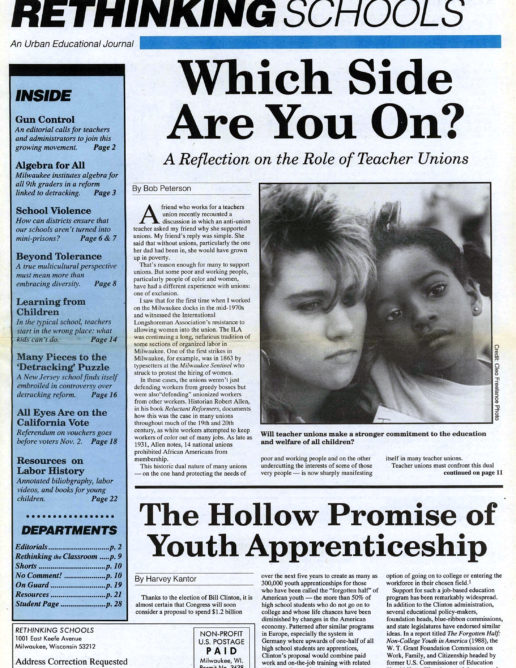School Security: Real Safeguards or Mechanical Shortcuts?
The Cincinnati Public Schools administration has proposed a $2 million package of safety measures that, at first glance, seems like a timely response to fears of increased youth violence.
But it is worth asking whether the proposal is based on a thoroughgoing analysis of what makes schools safe or is simply a list of mechanical devices designed for use in other settings such as airports and courtrooms.
The district plans to establish a school crime hotline, install security entrance systems with cameras, buzzers, and monitors, require I.D. badges, begin video surveillance on yellow buses, and use metal detection equipment. Establishing a highly-trained security response team, centralizing school-based “resource” (police) officers, and increasing 2-way radio communication are less controversial features of the plan.
It is worth asking whether these proposals will actually reduce risk or increase it. Dangerous activity is not something that goes on outside of and separate from schools. Schools are institutions that by nature reflect the communities in which they are located. Violence and crime are found in every neighborhood and in the homes of many students, regardless of race or income.
Schools should be given any mechanical device necessary to reduce the risk of harm to students and staff. But for those schools whose leadership has failed to organize an academically focused environment, no benefits will come from metal detectors. In such schools — and there are such schools, identifiable by years of poor test scores and out-of-control discipline — the mentality of purposelessness and victimization that accompanies violence, drugs, and weapons has already been invited into the building with open arms. In a school that doesn’t work academically, the danger isn’t “out there,” so attempts to keep it “out there” will do little to make that school a place where staff and students feel safe.
We must also recognize that there are dangers in our schools, affecting thousands of students daily, that are far more pernicious than the relatively rare occasion of a student with a weapon. These ever present dangers include classes full of students reading four years behind grade level, students changing schools three or more times a year, principals or teachers who accept unruly and disrespectful behavior, kids who live in the fifth generation of unemployment, and schools with filth, damage, and graffiti more appropriate to a detention center than a place that is supposed to stimulate creativity, curiosity, and love of learning.
The new security proposal is written just as one for an office building might be; it fails to recognize that these are youth who are still developing. The underlying concern seems to be the ability to formally prove who did what to whom, as opposed to facilitating the development of relationships among children and adults or creating an environment where people care about each other too much to allow anything or anyone to threaten safety. That, in fact, is what describes those Cincinnati public schools which havecreated an academic environment.
School security is a people problem — it requires a people solution. More security aides and bus monitors would help. Tools to help teachers and parents connect (like access to telephones and postage to mail home report cards, midterm reports, and invitations to school events) can help the school understand problems before violence results.
Every major national reform report recommends breaking large high schools into family groupings to reduce the anonymity that promotes an “anything goes” mentality and prevents teachers from knowing the names of those students who pass by them in the halls.
What other changes should be considered to enhance security instead of such a focus on mechanical solutions? We need treatment for students with alcohol and drug problems and psychological help for thousands of students who are physically or sexually abused and neglected. We need a mobility/transfer policy that creates stability in the lives of students whose home situations are anything but stable. We need to stop schools from “exporting” their serious discipline problems to schools with low enrollment, and get rid of administrators who cannot bring a school together and move it forward.
Finally, we need to stop looking for mechanical solutions to problems in human relationships. Children cannot raise themselves, and if we adults continue to force them to do so, we will only see a steady increase in their use of adult weapons and a decrease in their acceptance of our rules.
There is no short cut to giving our kids the adult attention and help they need. It would be better in the long run than turning our schools into armed fortresses, only to decide years from now that doing things cheaply never substitutes for doing them correctly.

